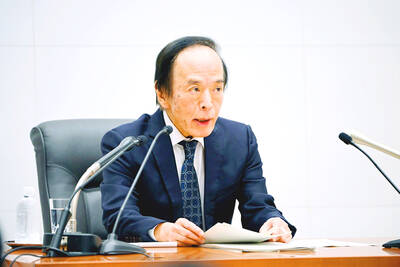■ Executives indicted
Shinkong Financial Holding Co (新光金控) chairman Eugene Wu (吳東進) and his finacial adviser Wu Tung-hsiung (吳統雄) were indicted yesterday by the Taipei District Prosecutors' Office on suspicion of insider trading, after the collapsed merger between Shinkong Financial and Taishin Financial Holdings Co (台新金控) in 2002. The two companies announced on June 25, 2002, that they would merge in a share swap deal. But to facilitate the deal, Taishin had asked Shinkong to set aside an additional NT$19.6 billion to cover potential losses stemming from higher insurance policy claims. Because of the additional provision, Shinkong later decided to report an after-tax loss of NT$8.82 billion instead of an earlier forecast of NT$3.96 billion profit that year, which angering Taishin, which called off the merger on July 3 the same year. Prosecutors accused Eugene Wu and Wu Tung-hsiung of insider trading of stocks, as they allegedly sold the Shinkong shares they owned two weeks before the announcement of revised financial forecast. Taishin chairman Thomas Wu (吳東亮) is the younger brother of Eugene Wu.
■ CAL, Delta share codes
Taiwan's leading carrier China Airlines (CAL, 華航) said yesterday it will expand code-sharing services with US-based Delta Air Lines starting Monday. CAL will add three additional code-sharing destinations on Delta flights from Los Angeles to Orlando, Fort Lauderdale and Tampa while Delta will place its codes on CAL flights from Taipei to Bangkok and Kuala Lumpur, it said. The new services will allow passengers to fly to Atlanta, Cincinnati, Salt Lake City, Orlando, Fort Lauderdale and Tampa via Los Angeles, or from San Francisco to Atlanta, or from Honolulu to Los Angeles and San Francisco. CAL will operate 13 destinations in the US after the expanded code-sharing. Meanwhile, Delta will place its codes on CAL flights from Honolulu, Los Angeles, New York (JFK), San Francisco and Seattle to Taipei, and onward to Bangkok and Kuala Lumpur.
■ E-mail filter launched
New e-mail filtering software developed by two domestic universities was launched yesterday, with its creators claiming it can filter some 97 percent of junk mails, the National Chung Cheng University (NCCU) announced. According to Kuo Yao-huang (郭耀煌), the software, dubbed "Nopam, " was jointly developed by NCCU and National Tsinghua University, and can handle more than 1 million e-mails in Intel Pentium 4 computers per day, with the error margin of less than 0.01 percent. This software will be offered to various schools or academic sectors of the country for free, Kuo said, adding that he is proud of the achievement. NCCU Professor Lee Hsing-lin (李新林) noted that the research and development of computer software is quite difficult in Taiwan, as few entrepreneurs are willing to dedicate themselves to this area, and therefore it needs long-term efforts. Wu Sheng (吳昇), director of NCCU's Internet center, said some junk mails are disguised in different versions to elude e-mail filtering software, but Nopam can compare the sources, contents, titles, the similarity, or whether they are sent in quantities to find these junk mails.
■ NT dollar gains
The New Taiwan dollar continued gaining ground against its US counterpart, rising NT$0.013 to close at NT$31.892 on the Taipei foreign exchange market. Turnover was US$597 million, down from US$753 million the previous day.

Taiwan’s long-term economic competitiveness will hinge not only on national champions like Taiwan Semiconductor Manufacturing Co. (TSMC, 台積電) but also on the widespread adoption of artificial intelligence (AI) and other emerging technologies, a US-based scholar has said. At a lecture in Taipei on Tuesday, Jeffrey Ding, assistant professor of political science at the George Washington University and author of "Technology and the Rise of Great Powers," argued that historical experience shows that general-purpose technologies (GPTs) — such as electricity, computers and now AI — shape long-term economic advantages through their diffusion across the broader economy. "What really matters is not who pioneers

In a high-security Shenzhen laboratory, Chinese scientists have built what Washington has spent years trying to prevent: a prototype of a machine capable of producing the cutting-edge semiconductor chips that power artificial intelligence (AI), smartphones and weapons central to Western military dominance, Reuters has learned. Completed early this year and undergoing testing, the prototype fills nearly an entire factory floor. It was built by a team of former engineers from Dutch semiconductor giant ASML who reverse-engineered the company’s extreme ultraviolet lithography (EUV) machines, according to two people with knowledge of the project. EUV machines sit at the heart of a technological Cold

TAIWAN VALUE CHAIN: Foxtron is to fully own Luxgen following the transaction and it plans to launch a new electric model, the Foxtron Bria, in Taiwan next year Yulon Motor Co (裕隆汽車) yesterday said that its board of directors approved the disposal of its electric vehicle (EV) unit, Luxgen Motor Co (納智捷汽車), to Foxtron Vehicle Technologies Co (鴻華先進) for NT$787.6 million (US$24.98 million). Foxtron, a half-half joint venture between Yulon affiliate Hua-Chuang Automobile Information Technical Center Co (華創車電) and Hon Hai Precision Industry Co (鴻海精密), expects to wrap up the deal in the first quarter of next year. Foxtron would fully own Luxgen following the transaction, including five car distributing companies, outlets and all employees. The deal is subject to the approval of the Fair Trade Commission, Foxtron said. “Foxtron will be

INFLATION CONSIDERATION: The BOJ governor said that it would ‘keep making appropriate decisions’ and would adjust depending on the economy and prices The Bank of Japan (BOJ) yesterday raised its benchmark interest rate to the highest in 30 years and said more increases are in the pipeline if conditions allow, in a sign of growing conviction that it can attain the stable inflation target it has pursued for more than a decade. Bank of Japan Governor Kazuo Ueda’s policy board increased the rate by 0.2 percentage points to 0.75 percent, in a unanimous decision, the bank said in a statement. The central bank cited the rising likelihood of its economic outlook being realized. The rate change was expected by all 50 economists surveyed by Bloomberg. The